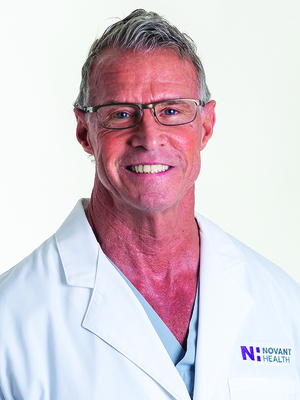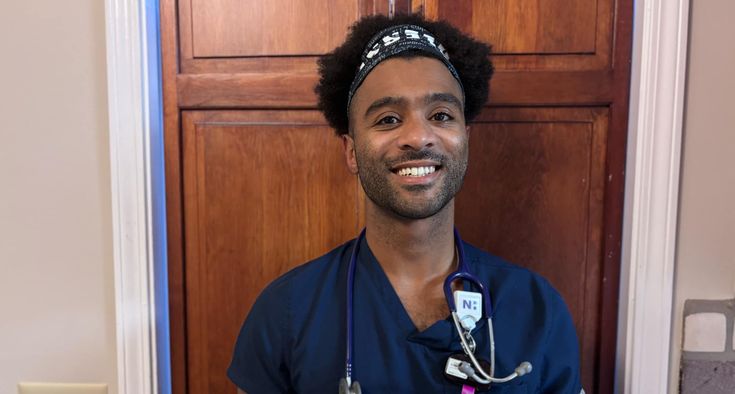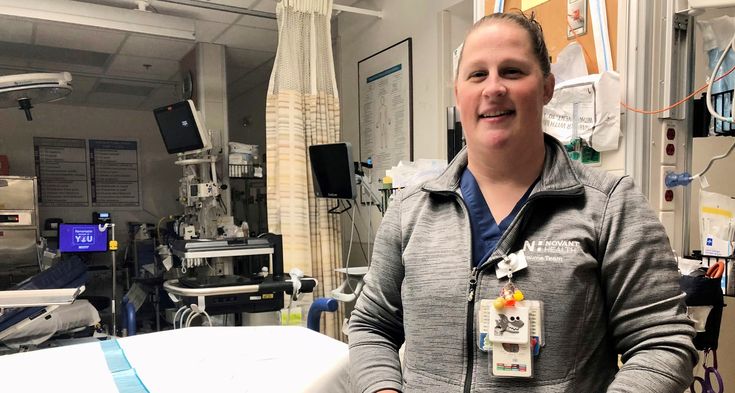When Gina Aldinger experienced shortness of breath and flu-like symptoms in October 2024, she thought it might be COVID. As a longtime smoker, she was used to having some shortness of breath, so she wasn’t overly concerned. It was about a week before she went to her primary care doctor.
Because she suspected COVID, she couldn’t enter her doctor’s office. A nurse came to her car and checked her blood oxygen level. It was 60. A normal reading would be around 95%. Anything lower than 88% typically requires immediate medical attention.
“They thought the meter was broken,” Aldinger, 64, said. “They kept checking it, and finally, they asked my doctor to come out to my car. He was surprised I’d been able to drive myself to his office. He told his team to call an ambulance because I needed to get to the ER right away.”
EMTs administered oxygen and rushed her to Novant Health New Hanover Regional Medical Center. It was there she learned that what she thought was COVID was chronic obstructive pulmonary disease – COPD.
Respiratory services designed to help you thrive.
Aldinger spent two nights being cared for in the hospital. Her husband, Rich, a car buyer for Matthews Motors in Wilmington by day and musician by night, was so grateful for the care his wife received that he felt compelled to thank her care team – in a song.
And he recorded it and shared it with the team.
“The staff was wonderful,” Aldinger said. “I didn’t feel all that sick, even though I was on oxygen the whole time.”
Tony Bollhorst, a Novant Health pulmonary disease navigator, was dispatched to Aldinger’s home to teach her how to use her oxygen tank and albuterol breathing treatment. But, as usual, he did a lot more than that.
‘He’s a saint’
Bollhorst is really in the business of changing lives.
He’s passionate about helping smokers quit and often tells patients, “This is a struggle between the real you and the addicted you. Let the real you win.”
He became a respiratory therapist in 2008 and a pulmonary disease specialist in 2016. His unsuspecting patients think he’s just there to demonstrate equipment.
Best doctors. Amazing nurses. Remarkable care.
“He was so inspirational,” Aldinger said. “He didn’t just talk to me about my future; he talked to me about my and Rich’s future. He gave me his number and said to call day or night if I needed anything. He did everything in his power to get me to stop smoking.”
Spoiler alert: It worked.
Rich was equally impressed. “Tony connected with my wife on a spiritual level,” he said. “To me, he’s a saint. I’m amazed at the effect he had on her.”
Rich, a nonsmoker, “has always been super supportive,” his wife said. “He’s never nagged me. I’ve known I needed to quit for a long time, but he didn’t push me.”
The first thing Bollhorst does when meeting a new patient is listen. Not every smoker is ready to quit, and if he senses that, he won’t push. But if he sees a way to reach them on an emotional level, he’s unstoppable. He makes his patients feel that they – and not their addictions – are in control.
“You can’t just say, ’Smoking’s bad for you. They already know that,” he said. “You can’t say: COPD is the third-leading cause of death in the world. That’s not helpful. They need an emotional reason to quit. I call that ‘the why that makes you cry.’”
People’s “whys” differ. Bollhorst is like an anti-smoking Sherlock Holmes, sleuthing out the “hook” that might prompt someone to quit.
For Aldinger, it was her faith.
“Gina is deeply spiritual, and that’s the angle Tony used in talking to her,” Rich said. “With Jesus as his co-pilot, he basically said, ‘God doesn’t want you to smoke.’ That hit her right between the eyes. Tony is magical. I’m in awe of him and hold him in the highest regard.”
Every smoke-free day is a victory
Bollhorst will never tell a smoker that what he or she needs is willpower. “Having willpower is resisting the urge to do something you want to do,” he said. “I don’t want people to just resist; I want to remove the urge. I try to give patients a new perspective on what life could look like as a nonsmoker.”
He’s adept at tugging at heartstrings, but he’s not all emotion. He comes armed with facts. He’ll explain how nicotine works in the body and let people know it’s not as formidable an opponent as it may seem.
“Nicotine is addictive, but it’s very weak,” he said. “Half the nicotine you inhale leaves your body within two hours. The other half leaves within five to seven days.” But, he said, each person still has the mental addiction and habit to break.
Bollhorst leaves patients with his cellphone number. He also often leaves an inspirational quote behind:
“Each day that you stay smoke-free is a victory and testament to your strength, motivation, determination and commitment to your health and to your future.”
He marked through “your” and wrote “our” in its place – in honor of Rich and his unconditional support. The couple, with two adult children between them, has been married a little over two years. Aldinger put it on her refrigerator, where she sees it daily.
She hasn’t had a cigarette since Oct. 21, 2024.
The only assistance she’s had – besides support from her family and Bollhorst – is NicoDerm gum. She doesn’t want to make it seem like it’s been easy, though. “The fact is: I’d still like to have a cigarette,” she said. “This hasn’t been easy, but I’m on a roll now. Why mess it up?”
She’s breathing easier these days – literally. She wasn’t aware of just how labored her breathing was before. Rich never told her, although it worried him. Her snoring has improved, too. Rich never told her this, either, but he used to occasionally get up in during the night and go into another room.
Bollhorst keeps track of all his patients. He checks in regularly during the more than three months he follows them. On their 100-day anniversary of being smoke-free, he sends a certificate to commemorate the milestone. Jan. 30 was Gina’s 100th day.
Bollhorst is too humble to accept any credit for her success. “Gina did the work,” he said. “She flipped the switch.”

When Tony Bollhorst’s favorite uncle died of emphysema at 57, he was devastated. “I watched him struggle to breathe and felt helpless,” he said.
But his uncle’s death was an awakening and he found his calling. “I wasn’t able to help Uncle Rich, but I want to see how many Uncle or Aunt Riches I can help.”
Most smokers – 70% – want to quit, he said. And over 90% have tried to quit.
They haven’t failed. Bollhorst never uses that word. “There is no failing when it comes to smoking cessation,” he said. “There are only stepping stones.”
If a longtime smoker goes a day or two without a cigarette and then has one, Bollhorst tells them not to be discouraged. He’ll say: “You didn’t fail; you just slipped” and remind them of their progress. “If someone who used to smoke a pack a day goes a couple of days without a cigarette and then lights up, they’ve still made progress.”
He’s like a magician with all sorts of things in his bag of tricks. He’ll tell patients: “You are a nonsmoker. Think of yourself as a nonsmoker. Call yourself one. Speak it into existence.”
There are lots of reasons someone might be compelled to stop smoking.
Bollhorst shares the story of a patient he once met at New Hanover Regional Medical Center. She’d been excited about her daughter and granddaughter coming to visit. She really wanted to walk on the beach with her 10-year-old granddaughter. But when the granddaughter walked in her house, she said, ‘Nana, you smell like smoke. Your house smells like smoke.’ She wasn’t being mean – just honest. The granddaughter didn’t stay with her, and it broke her heart.
Bollhorst somehow found a jigsaw puzzle online with a picture of an older woman and young girl walking on the beach. The puzzle was even called “Walking with Nana.” When he returned to the hospital the next day, he told his patient, “We’re going to get your granddaughter back. Every time you have a craving, I want you to work on this puzzle.”
The grandmother called Bollhorst one day to say she’d finished the puzzle but was still having cravings. He told her to tear the puzzle apart and put it back together again and to repeat as necessary.
She hasn’t smoked in two years.
Another patient used to smoke – and cough – on his patio every night after dinner. His smoking was causing a rift in his marriage. During Bollhorst’s “house call,” he told the couple how lovely their neighborhood was and suggested that a walk after dinner might be nice. It didn’t need to be a long walk, he said – just down the street.
They tried it, liked it and began walking a little farther each evening. They even began holding hands on their walks. Quitting smoking was good for the husband’s health – and his marriage.
For Bollhorst, it’s all in a day’s work.










